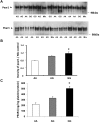Identification of a specific intronic PEAR1 gene variant associated with greater platelet aggregability and protein expression
- PMID: 21791418
- PMCID: PMC3179402
- DOI: 10.1182/blood-2010-11-320788
Identification of a specific intronic PEAR1 gene variant associated with greater platelet aggregability and protein expression
Abstract
Genetic variation is thought to contribute to variability in platelet function; however, the specific variants and mechanisms that contribute to altered platelet function are poorly defined. With the use of a combination of fine mapping and sequencing of the platelet endothelial aggregation receptor 1 (PEAR1) gene we identified a common variant (rs12041331) in intron 1 that accounts for ≤ 15% of total phenotypic variation in platelet function. Association findings were robust in 1241 persons of European ancestry (P = 2.22 × 10⁻⁸) and were replicated down to the variant and nucleotide level in 835 persons of African ancestry (P = 2.31 × 10⁻²⁷) and in an independent sample of 2755 persons of European descent (P = 1.64 × 10⁻⁵). Sequencing confirmed that variation at rs12041331 accounted most strongly (P = 2.07 × 10⁻⁶) for the relation between the PEAR1 gene and platelet function phenotype. A dose-response relation between the number of G alleles at rs12041331 and expression of PEAR1 protein in human platelets was confirmed by Western blotting and ELISA. Similarly, the G allele was associated with greater protein expression in a luciferase reporter assay. These experiments identify the precise genetic variant in PEAR1 associated with altered platelet function and provide a plausible biologic mechanism to explain the association between variation in the PEAR1 gene and platelet function phenotype.
Figures



References
-
- Bray PF, Mathias RA, Faraday N, et al. Heritability of platelet function in families with premature coronary artery disease. J Thromb Haemost. 2007;5(8):1617–1623. - PubMed
-
- Faraday N, Yanek LR, Mathias R, et al. Heritability of platelet responsiveness to aspirin in activation pathways directly and indirectly related to cyclooxygenase-1. Circulation. 2007;115(19):2490–2496. - PubMed
-
- Becker DM, Segal J, Vaidya D, et al. Sex differences in platelet reactivity and response to low-dose aspirin therapy. JAMA. 2006;295(12):1420–1427. - PubMed
Publication types
MeSH terms
Substances
Grants and funding
LinkOut - more resources
Full Text Sources
Other Literature Sources
Medical
Molecular Biology Databases

